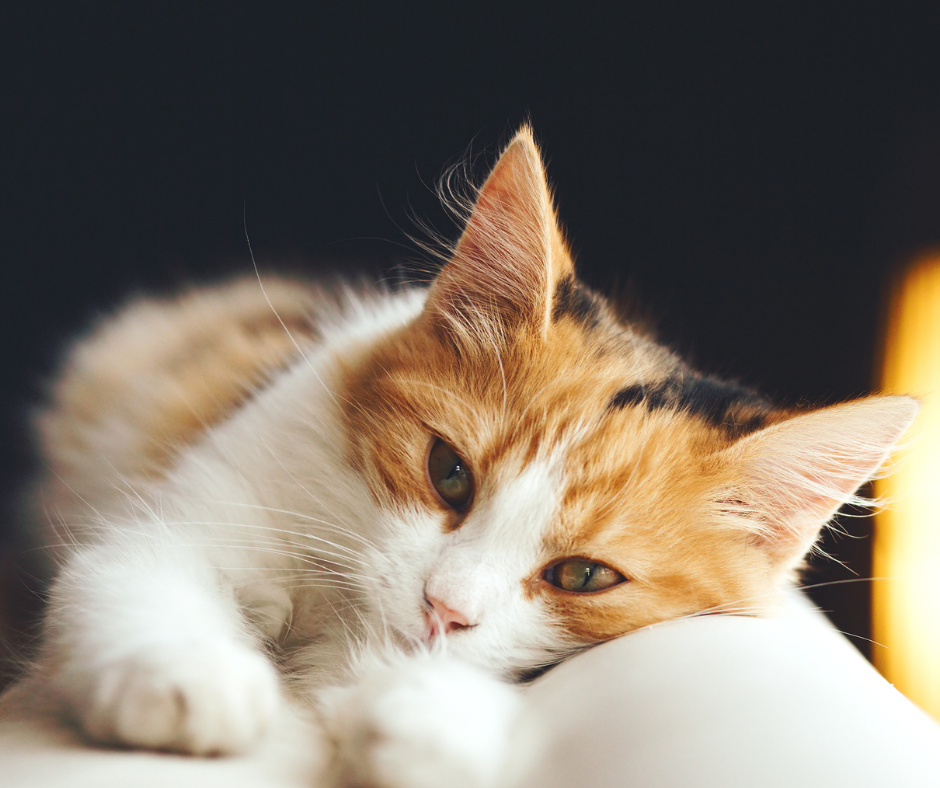Let’s talk all things cat fleas.
Those pesky little biters can be tough to spot and you might be wondering what fleas look like. They are tiny in size, at just a few mm in length, and usually dark brown or black. While they are wingless, they are Olympian jumpers, able to hurl themselves distances of around 200 times their body length. This makes them tricky to catch, and their flat body shape also means they are almost impossible to squash!
How to tell if a cat has fleas
You might not notice the occasional flea in your pet’s fur, although you can sometimes spot them jumping around during grooming. It is more common to notice little black specks in your cat’s coat, which are actually the droppings rather than the fleas themselves.
Flea droppings will look very similar to small flecks of mud, but you can use the ‘wet paper test’ to check. Brush some of the dark specks onto a sheet of plain, white paper which you should then dampen. This will usually leave little red streaks from dried blood if flea dirt is present – yuck!
If you spot a couple of fleas, treat your cat as soon as possible to prevent the fleas laying loads of eggs and multiplying! You can also use a flea comb to brush them out. Be sure to treat all your pets as fleas spread quickly, although you should always use the correct product and dose for their species, age, and body-weight. Your house will also need treating – more on that below…
Even if you don’t spot the fleas themselves, you might notice that your cat is scratching more often, or rubbing their head against furniture. Some felines are very sensitive to flea bites, and can show signs of an allergic reaction even just from one bite. This is referred to as flea allergic dermatitis (FAD) and will generally lead to fur loss (particularly around the head and tail), scabs, red irritated skin and pimples. In severe cases this can lead to skin infections, often due to all the scratching. If your cat is showing these signs they should see a vet for treatment to help settle down their skin flare-up.
What do flea bites look like?
Flea bites usually look like tiny red dots or bumps, although these can be difficult to find on your pet’s skin beneath all that fur. You may notice these on their belly, around their head or at the base of their tail. If your cat has FAD they will often have larger patches of red skin associated with these bites. It is best to seek veterinary advice for how to treat flea bites.

What do flea eggs look like?
Flea eggs are microscopic and often fall off your cat’s fur into the environment – outdoors or around the house. They’re too small for our human eyes but if you could see them, they would be a translucent white oval.
How do cats get fleas?
Cats can pick up fleas from other pets or from the environment when they are outside exploring. While indoor pets are at lower risk of catching fleas, it is still possible for fleas to come in on other pets who enter the home (including dogs), or people’s shoes and clothing. When you move house, there might already be fleas present if the previous owner had pets so you should consider a home treatment, particularly in carpeted rooms. Ask your local pet shop expert for advice.
Can fleas live on humans?
Cat fleas can bite humans, but they cannot survive on us for long. Flea bites on humans will usually cause small, itchy, red bumps. These can be found anywhere, but are more common on the lower legs and around the ankles. If you are concerned, speak to your GP for advice.
Can cat fleas live on dogs?
There are distinct species of flea that are referred to as ‘cat fleas’ and ‘dog fleas’. However, both can feed and live on either species. This means that cat fleas can live quite happily on your canine friends, and they’re actually the most common type of fleas found on dogs.
How long do fleas live?
Fleas will generally live for 2 or 3 weeks before being groomed out by the cat or their helpful human friend! Adult fleas are unable to survive off an animal, but it’s a different story when it comes to eggs and larvae. Each female can lay up to 2000 eggs during the course of their life. While these tend to hatch into larvae within a few weeks, they can lie dormant for a few months, particularly in carpets and under furniture. The larvae can also survive for months before becoming an adult. They can even survive during winter months, thanks to central heating.
Treating your home for fleas
It can take a long time to effectively get rid of fleas due to their lifecycle, which is one of the reasons that prevention is the best option. If you need to treat any of your pets for fleas, we would recommend treating your house too. Hoover regularly, paying particular attention to the edges of carpets, and around furniture legs as these spots are easy to miss and the ideal hiding place for immature fleas. There are also treatments that can be used on carpets and soft furnishings, but always take care to follow the guidelines as these can be very toxic. Don’t forget to wash your pet’s bed!
Ticks
Ticks can latch on to your cat, and are particularly common in woodland or grassland areas. These unpleasant-looking parasites swell up after feeding on your pet’s blood, and can carry bacteria and parasites that cause disease. Some flea products also help to protect against tick bites. Take care when removing a tick – avoid squeezing its body as this can increase risk of disease transmission to your cat. It is best to twist the tick as you remove it, which can be easier with a special tool. Accidentally leaving the tick’s head behind can increase the risk of infection, so speak to your vet for advice if in doubt.
Worms
There are loads of different types of cat worms. Most usually live in the cat’s intestines, but some species can also spend part of their lifecycle in your pet’s cardiovascular and respiratory systems. Cat worms are best avoided with preventative treatments. Some flea products will cover against certain types of worms, but you will often need an additional product too. Speak to your local pet specialist or vet for more info.

Prevention
Cats should be treated regularly for fleas, according to the guidelines of your preferred product. This will usually be once every month to three months. You should never use dog products on your cat as these can be extremely toxic.
Fleas can still jump onto your pet once they have been treated, but some products stop fleas surviving on your pet for a certain time after application. Spot-on treatments generally last for a period of weeks, and will kill any fleas that bite your pet during this time. However, other products will only kill existing fleas and do not have any lasting efficacy.
Vets can offer prescription-only flea products if necessary. These include tablets as well as spot-on treatments, and they tend to kill fleas more effectively or last longer after use. Vets may also give injections that prevent fleas from being able to lay eggs and multiply.
Want to stay up-to-date with the latest pet advice and products? Follow us on Facebook and Instagram.
Now you know the answer to what fleas look like, take a look at our article on grooming.


